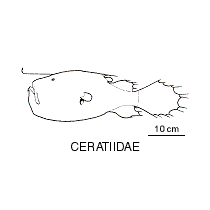- Classification
- ACTINOPTERYGII
- LOPHIIFORMES
- CERATIIDAE
-
Fish Classification
-
Class
ACTINOPTERYGII Ray-finned fishes -
Order
LOPHIIFORMES Anglerfishes -
Family
CERATIIDAE Seadevils
Family CERATIIDAE
The largest known deep-water anglerfishes. Females have relatively long, compressed bodies and small vertical mouths. They have a long "fishing rod" and bioluminescent lure on the snout and two or three soft fleshy wart-like bioluminescent appendages (caruncles) on the back.
The tiny males are permanent sexual parasites on the much larger females.
More Info
|
Family Taxonomy |
Small family of 2 genera and 4 species, all found in Australian waters. |
|
Family Distribution |
Ceratiids have a worldwide, circumglobal or cosmopolitan distributions. Ceratiids are broadly distributed at meso- to bathypelagic depthsat 120-2000 m in all three major oceans. Cryptopsaras couesii is found worldwide in tropical and subtropical latitudes. Members of the genus Ceratias are found from subarctic to subantarctic latitudes. |
|
Family Description |
Females have relatively long, slender compressed bodies with large heads, relatively small almost vertical mouths and small eyes buried in skin. The jaw teeth are slender, depressible and recurved, those in lower jaw slightly larger than upper jaw teeth. The oval gill opening is behind the pectoral-fin base. The illicium ("fishing rod") is either elongate or almost hidden by the tissue of the esca. The esca or bioluminescent lure is an oval bulb, with or without distal appendages. The posterior end of the illicial pterygiophore protrudes on the dorsal midline just before the fleshy bioluminescent caruncles on the back. 2 or 3 modified dorsal-fin rays or caruncles on back before soft dorsal fin, each with a bioluminescent gland. The skin is covered in spinules or spines. Males are much smaller than and parasitic on females. Fee-living males have large eyes and minute olfactory organs. They lack jaw teeth and have a pair of large denticular teeth on the snout, and two pairs of denticular teeth on the tip of the lower jaw. The skin is naked, becoming spinulose with growth. |
|
Family Size |
Females reach 120 cmTL, 77 cm SL; males to 14 cm SL. |
|
Family Feeding |
Reported to feed on fishes and crustaceans. |
|
Family Reproduction |
The sexes are separate and the tiny males are permanently parasitic on the much larger females. Larvae have a "humpbacked" body, wiht moderately inflated skin, small pectoral fins and no pelvic fins. Larvae are sexually dimorphic. Females have caruncles and an illicial rudiment. Larvae begin metamorphosis at 8-10 mm SL. |
|
Family Remarks |
Females of this family are the largest known deepwater (ceratioid) anglerfishes known, and may be up to 60 times larger than the tiny males of the same species. |
|
Author |
Dianne J. Bray |
References
Bertelsen, E. 1943. Notes on the deep-sea angler-fish Ceratias holbölli Kr. based on specimens in the Zoological Museum of Copenhagen. Vidensk. Medd. fra Dansk Naturh. Foren. 107: 185-206.
Bertelsen, E. 1951. The ceratioid fishes. Ontogeny, taxonomy, distribution and biology. Dana Rept. 39: 276 pp.
Bertelsen, E. 1984. Ceratioidei: Development and relationships. pp. 325-334, In Moser, H.G., W.J. Richards, D.M. Cohen, M.P. Fahay, A.W. Kendall, Jr. & S.L. Richardson (eds.), Ontogeny and Systematics of Fishes, Spec. Publ. No. 1, Amer. Soc. Ichthy. Herpet. ix + 760 pp.
Clarke, R. 1950. The bathypelagic angler fish Ceratias holbölli Kröyer. Disc. Rept. 26: 1-32.
Munk, O. & P.J. Herring. 1996. An early stage in development of escae and caruncles in the deep-sea anglerfish Cryptopsaras couesi (Pisces: Ceratioidei). J. Mar. Biol. Assn. U.K. 76: 517-527.
Pietsch, T.W. 1975. Precocious sexual parasitism in the deep-sea ceratioid anglerfish Cryptopsaras couesi Gill. Nature 256: 38-40.
Pietsch, T.W. 1976. Dimorphism, parasitism and sex: reproductive strategies among deepsea ceratioid anglerfishes. Copeia 1976(4): 781-793.
Pietsch, T.W. 1986. Systematics and distribution of bathypelagic anglerfishes of the family Ceratiidae (Order: Lophiiformes). Copeia 1986(2): 479-493.
Pietsch, T.W. 1999. Ceratiidae: Seadevils (deepsea anglerfishes), p. 2035, In Carpenter, K.E. & V.H. Niem. Species identification guide for fisheries purposes. The living marine resources of the western central Pacific. Batoid fishes, chimeras and bony fishes. Part 1 (Elopidae to Linophrynidae). FAO, Rome.
Pietsch, T.W. 2005. Dimorphism, parasitism, and sex revisited: modes of reproduction among deep-sea ceratioid anglerfishes (Teleostei: Lophiiformes). Ichthyol. Res. 52: 207-236.
Pietsch, T.W. 2009. Oceanic Anglerfishes: Extraordinary Diversity in the Deep Sea. University of California Press, 576 pp.
Pietsch, T.W. & Kenaley, C.P. 2006. Ceratiidae. Seadevils, caruncled seadevils. Version 17 April 2006 (under construction). http://tolweb.org/Ceratiidae/22010.04.17 in The Tree of Life Web Project, http://tolweb.org/
Saruwatari, T., T.W. Pietsch, A.M. Shedlock, I. Oohara, K. Itaya, T. Chiyotani, M. Abe, K. Ishihara, A. Sakai, A. Sugawara, T. Inagaki, K. Ishida, T. Komatsu, T. Sakai & T. Kobayashi. 2001. Sibling analysis between female and parasitic males of a ceratioid anglerfish (Cryptopsaras couesi, Ceratiidae, Teleostei). DNA Polymorphism 9: 82-85. [In Japanese.]

















